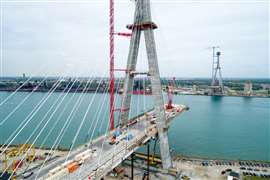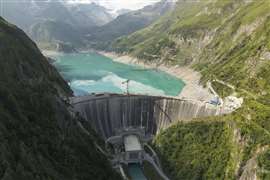The battle to build the Gordie Howe International Bridge
24 August 2023
With a span of 853 meters, the Gordie Howe International bridge linking the US and Canada, will be the longest cable stayed bridge in North America. Lucy Barnard finds out why it is being built and the many construction challenges it has overcome so far.
In February 2022, a group of Canadian truck drivers angry about covid vaccine mandates, parked their vehicles across a stretch of road leading to North America’s busiest border crossing and waited.
For almost a week, truckers waving Canadian flags stopped traffic from crossing the Ambassador Bridge which links the metropolitan areas of Windsor, Ontario and Detroit, Michigan, costing the country an estimated US$300 million a day.
The bridge handles around 27% of trade between the USA and Canada and the protests highlighted a weak link in the supply chain to Canadian authorities.
Owned by the influential Mouron family, the suspension bridge is also 92 years old.
 The trucker protest at the Ambassador bridge, in Windsor, Ontario, Canada, February 7, 2022. Courtesy of Freedom Convoy 2022 via Reuters
The trucker protest at the Ambassador bridge, in Windsor, Ontario, Canada, February 7, 2022. Courtesy of Freedom Convoy 2022 via Reuters
In 2001, the Canadian government, and others, worried that the ageing bridge would not be able to cope with projected traffic flows, commissioned a study investigating the problems with the border crossing and the infrastructure needed to solve them.
Its answer was the CN$5.7bn Gordie Howe International Bridge, a 2.5-kilometer, six-lane, state-owned bridge just a few miles away from the Ambassador Bridge, and which is currently being built linking the Interstate 75 in Michigan, US with Highway 401 in Ontario, Canada.
Named after Canadian ice hockey player and Detroit Red Wing’s star, Gordie Howe, the bridge, which is expected to be completed in 2025, is set to be the longest cable stayed bridge in North America and is being trumpeted as a symbol of North American unity.
“The design of the Gordie Howe International Bridge serves as a symbol of the unique and vital partnership between Canada and the United States,” says Grant Hilbers, Vice President, Engineering, Windsor-Detroit Bridge Authority, the most senior engineer on the project and the man responsible for overseeing construction of the bridge.
Keen to retain the US$60m in tolls made each year by the Ambassador Bridge, owner Manuel Mouron spent decades fighting to prevent the Gordie Howe being built until his death in 2020.
Canada agrees to pay for the bridge
Nonetheless, in 2012, after much political wrangling a deal was struck between the Prime Minister of Canada and the Governor of Michigan where the Canadian government agreed to pay for, build and operate the bridge through a public private partnership, while the completed bridge will be jointly owned by Canada and the State of Michigan.
In July 2018 the Windsor Detroit Bridge Authority, the public body charged with masterminding the bridge build, awarded a fixed-price main contract worth US$5.7bn to Bridging North America, a consortium of AECOM, Dragados, Fluor, Aecon and ACS, to build, maintain and manage the bridge. Construction started shortly afterwards in October 2018.
One of the first decisions made by Bridging North America was the design of the new bridge. Instead of building another suspension bridge to cross the border, it chose instead to opt for a cable stayed bridge.
 A rendering of the completed Gordie Howe International Bridge. Image: WDBA
A rendering of the completed Gordie Howe International Bridge. Image: WDBA
“The cable-stayed bridge design is a modern and elegant form with a tower shape inspired by the curvature of a hockey stick in a slap shot – a nod to Gordie Howe,” says Hilbers.
Like suspension bridges, cable stayed bridges rely on cables above them for support rather than columns below, enabling the Gordie Howe bridge to be built without the need to build piers in the riverbed – something which would have caused disruption to the busy shipping lanes of the Detroit River.
Traditionally used for shorter spans than their suspension bridge cousins, over the last twenty years, improvements in structural design software have enabled engineers to create longer and more efficient cable stayed bridges, which are generally cheaper and easier to construct than suspension bridges.
With a span of 853 meters (0.53 miles), the Gordie Howe International bridge will be the longest cable stayed bridge in North America when it is completed. Nonetheless, engineers expect it to only be the tenth longest in the world. Russia’s Russky Bridge in Vladivostok, built in 2012, holds the record for the longest at 1,104 meters.
The Gordie Howe International Bridge is designed as a continuous curve, anchored at each end by two inverted Y-shaped towers which suspend the bridge deck via 216 stay cables – 108 on each side.
At first, the team had planned to build the main deck of the bridge using a balanced cantilever construction method which would have involved building the two 220-meter-tall towers on either side of the river and then building the bridge piece-by-piece outwards until the two 425-meter-long cantilevers met in the middle.
But by summer 2019, with the prospect of a hard Detroit winter closing in and bad weather delaying the build, Hilbers and his team decided to change track, opting instead to use a technique called the ‘unbalanced cantilever system’ or ‘stick build.’
How is the bridge being built?
This meant that instead of the same level of construction occurring on each side of the tower, Hilbers’ team decided to build the ‘back’ span of the bridge first (the bit connecting the pylon with the approach road), with temporary supports that will be removed once all the cables have been installed.
“One of the challenges that the team overcame was the approach to construction of the bridge. Original methods followed the traditional balanced cantilever construction,” he says. “Obstructions in early days including limited water access, deep soft clay and winter weather lead Bridging North America to re-visit this erection method and select the unbalanced cantilever method for this build.”
Another major technical challenges, Hilbers says, was digging foundations deep enough to support the bridge’s two 220-meter towers close to the river’s edge.
He points out that a geotechnical survey showed that the ground in the Detroit-Windsor area consisted of layers of lumps of rock, clay and sand, formed during the ice age. In some parts these had cemented together, creating confining layers of impermeable rock which trapped groundwater.
Moreover, organic debris in the rock also produces hydrogen sulphide gas, a highly toxic, corrosive and flammable gas that smells of rotten eggs and requires workers to take extra precautions.
To complicate matters further, the ground beneath Detroit-Windsor also contains some of the world’s largest salt reserves and is criss-crossed with salt mines, many of which were excavated as long as a century ago and are either unmapped or poorly mapped. Reports from the 1950s of a large sinkhole opening up and swallowing a warehouse on the Canadian side of the river added to feared that shafts sunk in the wrong location could result in the foundations collapsing.
All of this meant that significant investigations were required to ensure that none of the planned foundations hit a mining cavity and, once the alignment of the bridge had been decided, it could not be changed.
Each of the legs of the two giant inverted Y shaped towers holding the bridge is supported by six shafts which have been drilled into the bedrock to a depth of 36 meters. Then, each of these shafts is filled with approximately 262,000 litres of concrete. The footings are then connected by 1,600 meters of post tensioning cables to create a firm footing.
 The Gordie Howe International Bridge seen from the Canadian side in July 2023. Photo: Windsor-Detroit Bridge Authority
The Gordie Howe International Bridge seen from the Canadian side in July 2023. Photo: Windsor-Detroit Bridge Authority
Other major challenges facing teams have included the covid pandemic, which occurred just as construction work on the bridge was ramping up in 2020, as well the supply chain issues and labour shortages which followed.
In June 2023, the Windsor-Detroit Bridge Authority announced that it had appointed enginner Charl van Niekerk as its third official chief executive officer, taking over from Bryce Phillips who resigned from the job at the start of the year.
Although officials at the Windsor Detroit Bridge Authority say they continue to target the contractually agreed opening date of 2024, they agree that the timetable could slip. Last year, an analyst report by S&P Global suggested that the project would be delayed by eight months until August 2025.
Meanwhile, on the Detroit River, construction works continue. Probably the most noticeable is the two bridge towers which in summer 2023 had reached 190 meters of their planned 220-meter heights.
Like most tall tower and bridge projects requiring concrete pours, the towers are being built using a “jump-form” method where teams pour concrete from ready-mix trucks into formwork moulds and rebar and wait for it to set. Then, using a series of support brackets and screw jacks powered by electric motors, the block is slowly lifted to the next level, forming a tower.
And, since the start of the year, the team has also been busy installing the thick metal cables which will eventually take the weight of the bridge.
So far, 28 of the 216 stay cables have now been installed, each comprising between 38 and 122 metal strands threaded through a high density polyethylene plastic pipe to protect it from the weather.
“With each new stage of construction, the distinctive design of this cable-stayed bridge takes shape,” says Hilbers. “As the stay cables are installed, the Gordie Howe International Bridge’s inspiring, modern and elegant features will become more visible for residents of Windsor and Detroit.”
STAY CONNECTED


Receive the information you need when you need it through our world-leading magazines, newsletters and daily briefings.
CONNECT WITH THE TEAM











